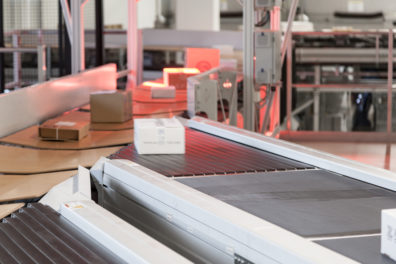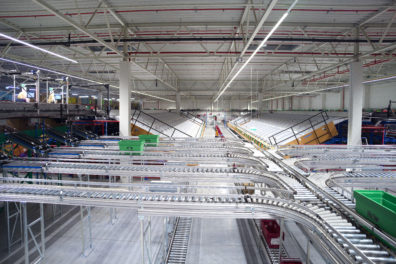Interview with Thomas Wiesmann, Director Sales Logistic Systems at BEUMER Group
At LogiMAT in Stuttgart, BEUMER Group presented its newly developed BG Sorter from the sortation and distribution technology segment. The high-capacity system enables precise and controlled processing of a wide variety of packages. The system integrator also has an efficient warehouse control system in its range for optimum flow of goods. In an interview, Thomas Wiesmann explains how users can benefit from this comprehensive competence and what trends they can expect. He is Director Sales Logistic Systems at BEUMER Group.
Mr. Wiesmann, at LogiMAT you showed the newly developed BG Sorter, which BEUMER Group first presented in 2018. How was the high-speed sortation system received in the market?
Wiesmann: Very well. We have already been able to implement some exciting projects since the market launch. This includes, for example, the new distribution centre of Austrian Post in Wernberg in Carinthia. Up to 30,000 parcels are handled on a daily basis. Our BG Sorter is at the heart of the centre. Availability, reliability and, above all, speed are valuable assets in this industry and are of paramount importance to our customers. With our system, Austrian Post will be the only parcel service provider in Austria to deliver parcels six days a week, from Monday to Saturday. The BG Sorter is powerful, energy-efficient and extremely quiet – much to the benefit of the employees.
What makes this high-capacity sorter so special and how do users benefit from it?
Wiesmann: With our BG sorter, operators benefit from very precise and controlled sorting with maximum flexibility. This means that both tilt tray and cross-belt sorters can be used in customer systems. The new sorter family provides the ideal variant for any type of items. The BG Sorter CB (“cross belt”) is a reliable solution for sorting a wide variety of articles such as parcels and bags. The so-called “full cross belt design” means that the maximum belt width is ensured. The actual benefit for the customer: More usable belt area is available with the same sorter size. The risk that products remain lying between the belts is reduced. The tilt tray design also offers some advantages. We have designed the tilt trays so as to prevent items from getting stuck between the trays. The so-called “closed deck” closes the gap between them. This function reduces downtimes and avoids possible damage to the sorter or the goods. Users can handle items of different sizes with more flexibility. The tilt tray version can transport items weighing up to 60 kilograms. Furthermore, the construction series is available either with the proven OptiDrive, which is based on servo drives, or the contactless linear synchronous motor as the drive system. Both reduce energy demand and CO2 emissions compared to products offered by our competitors.
With this development, you have combined the best of Crisplant technology with the best of BEUMER technology. Can you give us more information?
Wiesmann: Both Crisplant, which today operates under the name of BEUMER Group A/S, and we have acquired extensive know-how in the development of high-quality sortation systems over decades. Since the acquisition in 2009, we have been able to expand our portfolio, exploit synergies and further expand our strengths in technology. The BG Sorter combines future-oriented features, which set new standards in sorting as large a product range as possible. Providing our customers with this scalable system, we facilitate their future growth and enable them to respond to changes in the market.
What demands do online retailers make on sortation technology today and how have they changed over the years?
Wiesmann: The competitive pressure on postal and CEP companies continues to increase. They must not only save costs, but also adopt a more environmentally conscious approach and follow market trends. Basically, material distribution technology is becoming more complex, and the systems must be able to perform increasingly specific tasks or adapt to changing conditions. Highly efficient processes are necessary to ensure quick delivery of parcels to the customer. Mail order companies are offering more and more products whose dimensions previously made it difficult to transport them automatically. In order to meet the increased performance requirements, more automation is required. In addition, the number of the required sortation and distribution systems is increasing, as more small-scale distribution centres are being built close to customers in order to be able to supply them even faster.
As a system integrator, you offer a flexible and modular warehouse control system (WCS) to control complete material flows in distribution centres from goods receipt to goods issue in real time. What are the features of this solution?
Wiesmann: Our WCS centrally connects and controls material flows from quality assurance, picking of goods and order picking to goods issue, always in accordance with the actual occupancy rate. How effective this system is can be seen, for example, in the new European logistics centre of the Polish automotive spare parts supplier Inter Cars near Warsaw. There it controls the packing and goods issue sorter as well as the put-to-light system in the goods receipt department, coordinates the automatic provision and application of the labels required for shipping the goods, and handles the routing of the individual items on the conveyor lines. This route planning optimises the performance of the system and controls the distribution of the various spare part types.
As an additional module we also offer our BG Fusion system to operators. This visual display system provides the operator with a web-enabled user interface for configuration, monitoring and reporting. It displays system data as alarms in a uniform and centralised way and shows status messages, fault messages and all relevant data. The entire system status can be monitored via the interface to the machine control. BG Fusion combines machine and order data so that the responsible employee can track the current order status in real time.
Why are such software systems becoming more and more important, and what are the concrete benefits for the user?
Wiesmann: The software systems serve as link between the customer’s enterprise resource planning (ERP) or warehouse management system (WMS) and the entire material flow equipment. They ensure that the products reach the right place in the desired time within the distribution centre. Operators can perfectly coordinate their processes, increase throughput and reduce costs. With our know-how in sortation technology, we know exactly how to use these systems so that the user gets the most value out of it.
When developing the WCS software, what did you focus on?
Wiesmann: Unlike many competitors, our focus is not on adapting the customer’s processes to the WCS. We rather adapt the system with its modular design to the respective needs of the customer on a project-by-project basis.
Outlook for the future: What challenges do you see for the logistics industry, and how must providers develop their IT skills?
Wiesmann: E-commerce is picking up speed and we are expecting double-digit growth per year in this area. In order to hold their own against competitors, the future success of mail order companies and logistics service providers will depend even more on the performance of their distribution centres. To increase performance, digitisation is inevitable.
What does that mean in concrete terms for us as suppliers? To position us for the future, we must complement our expertise in machines and systems, including the necessary software and controls, with digital innovation. We have competence in mechanical engineering. Here in Germany, there are many hidden champions who are global leaders with their products and systems. In my opinion, it is more convenient to adapt digital technologies for the required digital competence. For this purpose, we founded the BEAM GmbH in Berlin. With this autonomous company builder, we want to solve B2B challenges that are unique to the logistics industry in cooperation with start-up teams. For this we are planning on founding three start-ups per year and transfer them, consolidated under BEAM, into a separate company. Our goal is to open up new, but also disruptive business areas in logistics.
















